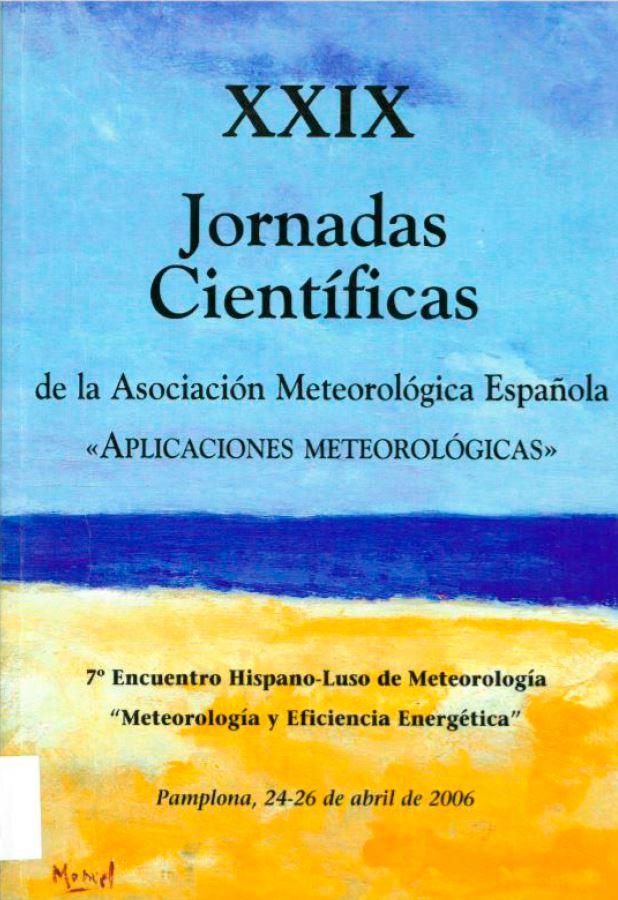VALIDACIÓN DE UN MODELO DE PREDICCIÓN METEOROLÓGICA EN TERRENO COMPLEJO: CARACTERIZACIÓN DE PROCESOS
Resumen
Los modelos numéricos son herramientas de uso frecuente en las ciencias de la Tierra. La evaluación de su habilidad para simular distintos procesos, es esencial tanto para su propio desarrollo como para verificar su aplicabilidad. Willmott y cols. (1985) consideran dos tipos de procedimientos de validación de modelos:- Validación Operacional: tiene como objeto determinar el grado de precisión con el que las predicciones del modelo se ajustan a las observaciones.
- Validación Científica: tiene como objeto determinar el grado de consistencia de los resultados del modelo con la teoría científica.
En su aplicación a la modelización meteorológica la Validación Operacional precisa la determinación de estadísticos y gráficos adecuados para evaluar la capacidad del modelo en reproducir observaciones de variables escalares (temperatura, humedad, presión,... etc) y vectoriales (viento). La Validación Científica ha de determinar el realismo y la consistencia de los procesos básicos simulados por el modelo, conforme al conocimiento a priori de los mismos y de su identificación en las observaciones disponibles. La metodología concreta a emplear en ambos procedimientos de validación dependerá del objeto del estudio, de la herramienta de simulación y de la información experimental disponible.
Citas
Badenas, C., Caselles, V., Estrela, M. J., and Marchuet, R. (1997) Some improvements on the processes to obtain accurate maps of sea surface temperature from AVHRR raw data transmitted in real time. Part. 1. HRPT images. International Journal of Remote Sensing 18, 1743-1767 Caplan, P., Derber, J., Gemmill, W., Hong, S. Y., Pan, H. L., and Parish D.: Changes to the NCEP operational medium-range forecast model analysis/forecast system, Weat. Forecasting, 12, 581-594., 1997. Fast, J. D., 1995a: Mesoscale modeling and fourdimensional data assimilation in areas of highly complex terrain. J. Appl. Meteor., 34, 2762-2782. Hanna, S.R., and Yang R.: Evaluations of mesoscale model simulations of near-surface winds, temperature gradients, and mixing depths, J. Appl. Meteor. 40, 1095- 1104, 2001. Heymann, Y., Steenmans, Ch., Croisille, G. and Bossard, M., (1994). Corine land cover A Technical guide, Office for Official Publications of the European Communities, Luxembourg. Mellor, G.L.; and Yamada, T. (1982): Development of a turbulence closure model for geophysical fluid problems, Reviews of Geophysics and Space Physics, 20, 851-875, Millán,M.M., Salvador, R., Mantilla E., and Kallos
G.,: Photooxidants dynamics in the Mediterranean basin in summer: Results from European research projects, J. Geophys. Res., 102 (D7), 8811-8823, 1997. Millán,M.M., Sanz M.J., Cosín S., Pérez-Landa G., Schumacher M., Gioli B. (2003). Regional assesment and monitoring of the carbon balance within Europe (RECAB). Chapter 7: Valencia summer and winter campaigns. Final report of the EC-funded project RECAB
Molinari, J., and M. Dudek, (1992): Parameterization of convective precipitation in mesoscale and numerical models: A review. Mon. Wea. Rev., 120, 326-344. Perez -Landa G., P. Ciais, M.J. Sanz, B. Gioli, F. Miglietta, J.L. Palau, G. Gangoiti, M.M. Millan, and: Mesoscale circulations over complex terrain in the Valencia coastal region, Spain. Part 1. Simulation of the diurnal circulation regimes. Atmospheric Chemistry and Physics, 2006.(En Prensa) Perez -Landa, G., P. Ciais, G. Gangoiti, J.L. Palau, A. Carrara, B. Gioli, F. Miglietta, M. Schumacher, M.M. Millan, and M.J. Sanz: Mesoscale circulations over complex terrain in the Valencia coastal region, Spain. Part 2. Linking CO2 surface fluxes with observed concentrations. Atmospheric Chemistry and Physics, 2005 (En Prensa). Pielke, R. A., Cotton, W. R., Walco, R. L., Tremback, C. J., Lyons, W. A., Grasso, L. D., Nicholls, M. E., Moran, M. D., Wesley, D. A., Lee, T. J., and Copeland, J. H., A comprehensive meteorological modelling system RAMS, Meteor. Atmos. Phys., 49, 69-91, 1992. Seaman, N. L., and Michelson S. A.,: Mesoscale meteorological structure of a high-ozone episode during the 1995 NARSTO-Northeast study. J. Appl. Meteor., 39 (3), 384-398, 2000. Stauffer, D. R., and Seaman, N. L.: Use of FourDimensional Data Assimilation in a limited-area mesoscale model. Part I: Experiments with Synoptic-Scale Data. Mon. Wea. Rev., 6, 12501277, 1990. Willmott, C.J.: On the validation of models. Phys. Geog., 2, 184-194, 1981. Wilmott, C. J., Ackelson S. G., Davis R. E., Feddema J. J., Klink K. M., Legates D. R., O’Donnell J., Rowe C. M.: Statistics for the evaluation and comparison of Models. J. Geophys. Res. 90, 8995-9005, 1985. Zhong, S., and Fast, J.: An evaluation of MM5, RAMS, and Meso ETA at sub-kilometer resolution using VTMX field campaign data in the Salt Lake Valley. Mon. Wea. Rev., 131, 1301-1322, 2003.

